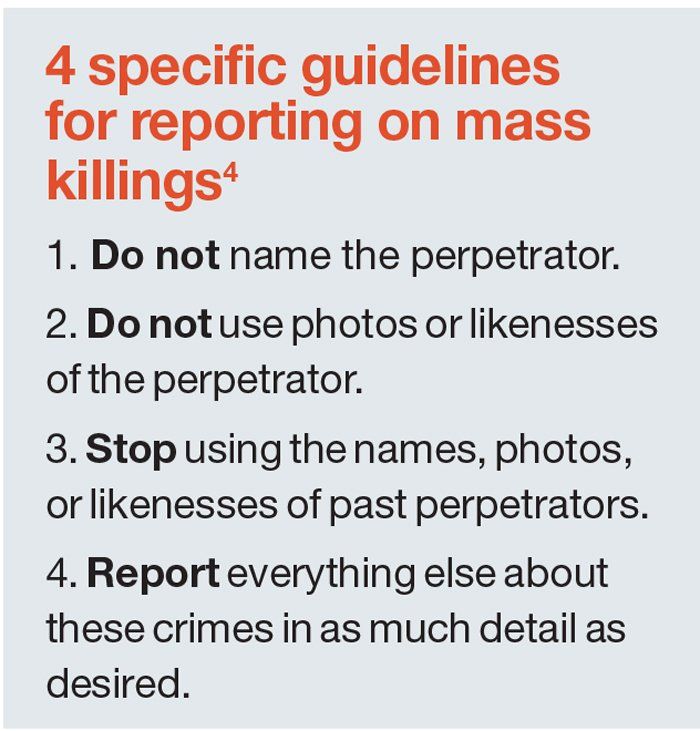Article
After Las Vegas, The Danger of Copy-Cat Killers
Author(s):
We can encourage more responsible media coverage of mass shootings in an effort to cut down on “copy-cat” killings. Here are 4 guidelines.
4 specific guidelines for reporting on mass killings[4]

If you go by the media coverage of the horrendous Las Vegas shootings, the most important thing now is to determine the precise motives of the shooter. The internet is bristling with all manner of speculation: was the killer angry with this group or that group? Did he act out of rage or hatred, etc?
Yet these are probably the least useful questions to be asking now. Rather, we need to be thinking ahead to the mass-shooters-in-waiting-the copycats who will use the Las Vegas murders as a template for their own horrific schemes. And we have good reason to believe that the more publicity the Las Vegas shooter garners, the greater the motivation of copycats to “dethrone” him with the next mass shooting. (The reader will note that I do not use the Las Vegas shooter’s name in this piece).
As my colleague, forensic psychiatrist Dr. James L. Knoll IV, has pointed out, narcissism and social rejection are established risk factors for aggressive behavior. He observes that media coverage given to mass shooting perpetrators “. . . has sent the message that committing a spectacular act of murder or killing is a great way to get attention.”1
One study by Dr. Paul Mullen2 examined the psychological profiles of 5 perpetrators of mass killings who were captured alive. Mullen found that, typically, these individuals were often bullied in childhood and had personalities marked by suspiciousness, obsessional traits, grandiosity, and persecutory beliefs. Generally, these were individuals who intended to kill as many people as they could and then kill themselves-and they were influenced by heavily publicized cases of other mass shootings.
Only a very small percentage of gun-related killings are attributable to clinically documented mental illness.3 The personality profile suggested by Mullen is far too common to be of predictive value-it would yield countless “false positives” for potential mass shooters. But we can encourage more responsible media coverage of mass shootings in an effort to cut down on copycat killings.
Recently, Professors Adam Lankford and Eric Madfis have proposed 4 specific guidelines for reporting on mass killings (see Box)4:
Given the “Wild West” character of the internet, it may be unrealistic to expect widespread adherence to these idealistic guidelines. Yet, we must push back against the tide of media hype and perverse glamour that washes over us in the wake of mass killings. As Lankford and Madfis observe, “. . . by no longer publishing the names or images of mass killers, the media would stop giving them the attention they often seek, and likely deter some future perpetrators from attacking.”4
This article was originally posted on 10/4/17 and has since been updated.
References:
1. Knoll JL. Mass shootings: research and lessons. Psychiatric Times. 2013. http://www.psychiatrictimes.com/disaster-psychiatry/mass-shootings-research-and-lessons/page/0/1. Accessed October 5, 2017.
2. Mullen PE. The autogenic (self-generated) massacre. Behav Sci Law. 2004;22:311-323.
3. Metzl JM, MacLeish KT. Mental illness, mass shootings, and the politics of American firearms. Am J Public Health. 2015. https://www.ncbi.nlm.nih.gov/pmc/articles/PMC4318286/. Accessed October 5, 2017.
4. Lankford A, Madfis E. Don’t name them, don’t show them, but report everything else: a pragmatic proposal for denying mass killers the attention they seek and deterring future offenders. Am Behav Sci. 2017. https://www.researchgate.net/publication/319560751_Don‘t_Name_Them_Don‘t_Show_Them_But_Report_Everything_Else_A_Pragmatic_Proposal_for_Denying_Mass_Killers_the_Attention_They_Seek_and_Deterring_Future_Offenders. Accessed October 5, 2017.





